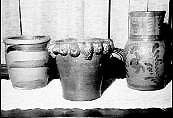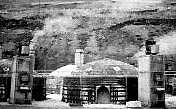
 Even when pottery could be obtained from Baltimore, it was extremely
expensive. Extensive deposits of Quaternary clay were readily accessible
from the terraces of the Monongahela River, and the clay was of superior
quality. At first terra-cotta china was made, followed later by stoneware
with a salt glaze. When James Thompson's grandson, Greenland, died in 1890,
the Morgantown pottery business ceased operation. Another pottery, the
Donahue stone pottery, was built in 1866 in Parkersburg. It specialized in
stoneware crocks, jugs, jars, earthenware, and flower pots, and used a 6 to 7
foot-seam of nearby Ohio River clay for the stoneware. The stoneware was
distributed locally through the Ohio Valley until the operation was
disbanded in the early 1900s. Newell and New Cumberland were other early
chinaware centers, and other earthenware plants were located at Wheeling,
Huntington, Weston, Williamstown, Mannington, Paden City, Ravenswood, and
Grafton. Today there are only a few chinaware manufacturers in the State,
none of which obtain clay locally, as the early potteries did. However, in
recent years independent potter craftsmen have begun to experiment with local
clays, as they find them plentiful, convenient, and inexpensive to use.
Another popular use of clay throughout the years has been for the manufacture
of brick to be used for building, paving, tiling roofs, and as fire brick for
furnaces.
Even when pottery could be obtained from Baltimore, it was extremely
expensive. Extensive deposits of Quaternary clay were readily accessible
from the terraces of the Monongahela River, and the clay was of superior
quality. At first terra-cotta china was made, followed later by stoneware
with a salt glaze. When James Thompson's grandson, Greenland, died in 1890,
the Morgantown pottery business ceased operation. Another pottery, the
Donahue stone pottery, was built in 1866 in Parkersburg. It specialized in
stoneware crocks, jugs, jars, earthenware, and flower pots, and used a 6 to 7
foot-seam of nearby Ohio River clay for the stoneware. The stoneware was
distributed locally through the Ohio Valley until the operation was
disbanded in the early 1900s. Newell and New Cumberland were other early
chinaware centers, and other earthenware plants were located at Wheeling,
Huntington, Weston, Williamstown, Mannington, Paden City, Ravenswood, and
Grafton. Today there are only a few chinaware manufacturers in the State,
none of which obtain clay locally, as the early potteries did. However, in
recent years independent potter craftsmen have begun to experiment with local
clays, as they find them plentiful, convenient, and inexpensive to use.
Another popular use of clay throughout the years has been for the manufacture
of brick to be used for building, paving, tiling roofs, and as fire brick for
furnaces.
 The earliest West Virginia brick plant was built near New Cumberland in 1832,
and bricks and fire clay were shipped to Pittsburgh and various other points
along the Ohio. In 1862, gas was struck nearby, and soon it was being
used for firing brick. The Standard Fire Brick Company was established in
1874 at a point called Globe, and still operates today as the Globe
Refractories, Inc. Numerous other clay plants grew up near New Cumberland,
using the Middle and Lower Kittanning fireclays to manufacture building
brick, paving block, and sewer pipe. In 1894, many of these plants were
consolidated by the Mack Manufacturing Company. The company has since
changed hands several times, and it is today called the Crescent Brick
Company. Both Globe Refractories and Crescent Brick produce bricks to be
used for ladles in the steel industry. The extremely high fusion point of
the Kittanning clay produces a good fire brick.
During the 1890s there were over 50 clay mines in the State. Today there
are 6 principal operations mining clay for fire brick, building brick, clay
stemming, and/or cement. However, there is great potential in West Virginia
for the development of the clay industry due to the numerous underclays
(associated with coals), surface clays, and shale beds.
(adapted from an article by Jane R. Eggleston, updated September 1996)
The earliest West Virginia brick plant was built near New Cumberland in 1832,
and bricks and fire clay were shipped to Pittsburgh and various other points
along the Ohio. In 1862, gas was struck nearby, and soon it was being
used for firing brick. The Standard Fire Brick Company was established in
1874 at a point called Globe, and still operates today as the Globe
Refractories, Inc. Numerous other clay plants grew up near New Cumberland,
using the Middle and Lower Kittanning fireclays to manufacture building
brick, paving block, and sewer pipe. In 1894, many of these plants were
consolidated by the Mack Manufacturing Company. The company has since
changed hands several times, and it is today called the Crescent Brick
Company. Both Globe Refractories and Crescent Brick produce bricks to be
used for ladles in the steel industry. The extremely high fusion point of
the Kittanning clay produces a good fire brick.
During the 1890s there were over 50 clay mines in the State. Today there
are 6 principal operations mining clay for fire brick, building brick, clay
stemming, and/or cement. However, there is great potential in West Virginia
for the development of the clay industry due to the numerous underclays
(associated with coals), surface clays, and shale beds.
(adapted from an article by Jane R. Eggleston, updated September 1996)
Please send questions, comments, and/or suggestions to webmaster.
Page created and maintained by:
West Virginia Geological and Economic Survey
Address: Mont Chateau Research Center
1 Mont Chateau Road
Morgantown, WV 26508-8079
Telephone: 1-800-WV-GEOLOgy (1-800-984-3656) or 304-594-2331
FAX: 304-594-2575
Hours: 8:00 a.m. - 5:00 p.m. EST, Monday - Friday
Permission to reproduce this material is granted if acknowledgment is given to the West Virginia Geological and Economic Survey.